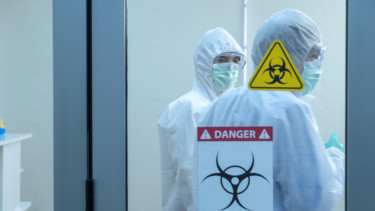COVID-19: New cases hit all-time high in Hungary


A year ago, the longer-term percent positive averages were all subsiding, while this year the Omicron variant has made sure the fifth wave in the coronavirus pandemic starts before the fourth wave is over. It is spreading extremely fast, doubling the number of cases every two days.

As the erratic testing practices have rendered the daily and even the short-term average positivity rates practically useless, we need to use longer-term averages to see where the pandemic is headed.

Here's our 'new' indicator, the 7-d / 28-day average and its 7-day average, for two periods: starting from 1 October 2021 and starting from 1 September 2020. Both are at their mid-Nov 2021 levels and climbing steadily.

The 7-day average has never been this high!


The 7-day rolling average of new COVID-19 keeps on rising, and the number of Covid deaths is likely to follow suit, unless the Omicron variant causes less severe disease than Delta. While this may be true on average, experts of the World Health Organisation (WHO) warned against taking Omicron lightly.
Maria Van Kerkhove, the WHO’s Covid-19 technical lead, warned last week that "it is not just a mild disease", stressing that "this is really important because people are still being hospitalized for Omicron."
Dr. Mike Ryan, director of the WHO’s health emergencies program, said last Wednesday that Omicron represents a “massive threat” to the lives of the unvaccinated.
The WHO has warned on Tuesday the pandemic will not end as the Omicron variant subsides in some countries, warning the high levels of infection around the world will likely lead to new variants as the virus mutates. New infections have increased by 20% globally over the past week with nearly 19 million total reported cases.

As you can see on the right-hand graph above and the one below, the 7-day average of Covid deaths has also started to rise, which is not really a surprise in light of the sharply rising number of new cases.

Here are a couple of charts depicting the sitation in hospitals.
On the two charts below the 0% line is important. When the curves are under 0% there’s a decline, when they go over 0% it’s an increase.
More importantly, when a value is north of 0% but the curve descends, it means an increase at a slowing rate, rather than a decrease. If the curve is above 0% and ascending, it is an increase at an accelerating rate. When we are under 0% and the curve goes lower, it translates into an accelerating decrease, and when it goes up it marks a decelerating decrease. As you can see, we are witnessing the latter here, and there was a turnaround in the improvement around 27-29 December. The number of active cases started to go up at an increasing rate at that time and the pace has only picked up. The changes in terms of hospitalisations and mechanical ventilation have been showing a similar start but then a different and mixed pattern. We need data for a couple of more days to see if the trend is changing for the worse or not, but an improvement would be surprising. The ascent of orange curve has already been tracked by the blue one, as we projected it would yesterday.


While about one third of the population (3.4 mn people) are inoculated with three doses of COVID-19 vaccines, about 3.5 million people have not received a single shot yet. Also, as the effectiveness of vaccines wanes over time, about three million Hungarians have diminished or no protection against coronavirus infection, even after two jabs.
The cabinet has announced a new vaccination campaign for January where Hungarians may, after on-site registration, ask for their first, second or third dose of a COVID-19 vaccine. The shots will be administered at vaccination locations between 2 and 6 p.m. on Thursdays and Fridays and between 10 a.m. and 6 p.m. on Saturdays.
A fourth shot (second booster dose) will be available for
- the elderly,
- the chronically ill,
- people on immunosuppressive treatment and transplant recipients,
- and in the disease groups listed by the Ministry of Human Capacities.


Cover photo: MTI /János Vajda







